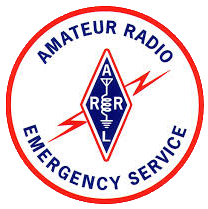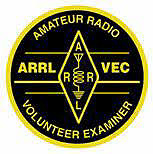Disaster Preparedness Month 2025
- Details
- Hits: 1234
September is National Preparedness month, and we'll continue our discussion of preparedness. It is fitting we cover the topic as a group, but even more so at home with your family.
Recent discussions have included a variety of people volunteering information about their preparation efforts (or lack of). The most recent West Georgia Amateur Radio Society (WGARS) featured a discussion between Sierra (K4SBE) and John (WD8LQT) regarding her deployments to disaster areas. That discussion focused on catastrophic events where, quite frankly, there is little any of us could do beyond wait for help (i.e. houses destroyed, infrastructure inoperable, etc). Probably the best advice for these types of events, especially if we know they are coming, is to wear a full set of clothes, even when going to sleep - so if something does happen you have some basic personal protection from the elements! We hope to have a video of that discussion available soon.
However, there are events that will not be quite so catastrophic as Sierra has seen, where preparation can do us some good; particularly in West Georgia, where the typical events will be weather related. It's rare that a large hurricane survives this far West and/or North of most landfalls, but that doesn't mean we won't get heavy rains, severe storms, and tornadoes that can still cause significant damage. We see severe weather of our own, but seldom is there widespread destruction.
So the good news is the probability of widespread destruction is low (but not zero). Nonetheless, there can (and will) be an interruption of services, including electricity, water, food, fuel, and other critical needs. Be sure you have a supply of these things and treat them like gold. You don't know how long you'll be without some critical infrastructure, so make what you do have last as long as practical.
So we're back to ensuring we have identified risks and have a plan which includes having supplies that will survive a power outage, flooding, and/or temperature extremes at least for a short while. Only if all of this has been done will it even be possible to provide assistance to your neighbors and community.
In a 2005 study Carroll County was the sixth most likely county in Georgia to experience some form of severe event, which have historically been weather related. We need to think about other potential risks as well, as emergencies, by definition, are unplanned events. That being said, most all emergencies require the same basic supplies, and usually require similar responses.
One exceptional situation would be if the emergency event requires evacuation rather than sheltering in place. While families would ordinarily make their way home with oncoming severe weather, an emergency requiring evacuation could result in family members evacuating to different places. In some cases family members may need to shelter in place away from home. Because of these situations, it is important that family members all operate off of the same plan, minimizing the understandable concern over a "missing" family member.
FEMA, GEMA, the Red cross, and other entities all provide useful information to assist in planning. Here's a checklist and tool kit FEMA provides to assist in the preparation process. Not surprisingly, many of the items in the previously mentioned check list came up during the recent WGARS meeting discussion.
We'll cover other aspects of preparing in future nets, but I would ask tonight, if anyone has suggestions for other resources to assist us in preparation? Has anyone ever resided in an actual disaster when the incident occurred, and what did you learn from it?
Amateur Radio, ARES, and RACES
- Details
- Hits: 1684
In previous ARES presentations I have made reference to other entities that either provide Emergency Communications services, or need the ability to utilize them during an emergency.
 While we focus on the Amateur Radio Emergency Service (ARES), sponsored by the ARRL, for providing emergency communications, the only entity recognized formally in FCC regulations is the Radio Amateur Civil Emergency Service (RACES). So what is RACES, and why do we hear so little about it?
While we focus on the Amateur Radio Emergency Service (ARES), sponsored by the ARRL, for providing emergency communications, the only entity recognized formally in FCC regulations is the Radio Amateur Civil Emergency Service (RACES). So what is RACES, and why do we hear so little about it?
RACES is recognized in FCC regulations Part 97, Section 407. RACES is a service comprised of Amateur Radio operators who report directly to a Civil Defense Agency like FEMA, GEMA, and local Emergency Management Agencies (EMA). The agency will create their own organization and sign-up radio operators who, when called up, operate under the jurisdiction of the agency they serve. Any of the entities may activate their RACES organization at their discretion.
While operating as a RACES station the operator is not to communicate with non-RACES authorized stations unless specifically instructed to do so by their served Civil Defense Agency. Under the Presidential War Powers Act normal Amateur Radio activity can be suspended, leaving the Amateur bands open for RACES operations exclusively during an emergency.
So, at this point you might ask why does ARES exist? Well, RACES only services Civil Defense entities, but there are other entities that may need Amateur Radio support. For instance, the Salvation Army and Red Cross may need Amateur Radio support specifically for their operations. Hospitals, such as Tanner Medical Centers, have unique needs. None of these entities are directly covered under the RACES program. It is theoretically possible for a County EMA director to deploy RACES operators to a hospital or other location to support other entities during an emergency, but those entities will be competing directly with the EMA director's own needs. ARES fills the gap, offering services to a variety of entities that may need operators focused on their needs, not merely part of a pool of operators shared by a Civil Defense agency.
As time has passed and ARES has grown, the way Civil Defense agencies handle securing Amateur Radio resources changed; recognizing the fact the probability of needing Amateur Radio at any given time is low, but management needs remain, many of these Civil Defense entities enter into agreements with ARES to provide operators who are dual registered as ARES and RACES operators. The served entity then has the freedom to activate RACES and the previously deployed ARES operators suddenly become RACES operators!
One benefit of RACES is that the served entity may be able to extend liability, medical, and workman's compensation insurance to the activated Amateur Radio operators, who qualify as employees, even if unpaid. Seldom is this done, but when it is, it is not so much compensation as an umbrella of protection for operators who may be placed in a situation where there is risk of injury or the need for liability protection. ARES, being essentially a contractor, would not be able to have such benefits extended to them.
Balloons and EMCOMM
- Details
- Hits: 1913
I often present material that ties recreational amateur radio activities to actual Emergency Communications activities. Balloon launches are another example of how our fun activities help prepare us for deployment or demonstrate why more of us should get up and running with a particular mode. In this case we often use APRS for getting into the immediate area where the balloon has landed and then switch to direction-finding to cover the last mile. We've covered direction-finding in foxhunt related presentations, so we'll cover primarily APRS here.
Will We Or Won't We (Deploy)?
- Details
- Hits: 2281
During Field Day (2025) a discussion of work being done outfitting the WGARS communications trailer digressed into a debate of whether Amateur Radio operators would ever really be deployed in a local emergency. One operator insisted it would never happen, while another acknowledged the probability was low, but it was not outside the realm of possibility.
The discussion was mostly centered around the fact that post 911/Katrina government communications systems are better integrated, allow various levels of inter-department and inter-agency communications
Deployable Antenna Support Systems
- Details
- Hits: 3712
We've spent a lot of time discussing training for deployment, what personal supplies we'd bring to a deployment, and what radio gear we would bring along, but what to do for antennas?
Yes, roll-up or J-pole antennas have been discussed often for years; to a lesser extent we have discussed low-flying HF (NVIS) antennas. We never know where our deployments may send us, and in many cases trees or other antenna supports may be some distance away, so extra coax and/or rope will be handy in those instances.
QRP And Amateur Radio
- Details
- Hits: 0
While many operators tend to operate using the 100W or 200W their radio provides, and yet others use external amplifiers to run hundreds, even more than 1KW, there are others who operate at the other end of the spectrum, 5-10 Watts.
QRP operation is often practiced by operators participating in Parks On The Air (POTA) or Summits On The Air (SOTA), who are often hiking or backpacking their equipment to the operating location, carrying their power source with them. Naturally, packing a Marine Battery would be a bit of a challenge, so smaller and lighter batteries with lower power capacity are used.
NTS and ICS-213 Messages
- Details
- Hits: 13357
Note: Images may be clicked for enlarged view
 The National Traffic System (NTS) has provided a means of passing messages (usually referred to as traffic) via Radiograms for almost as long as amateur radio has existed. Before long distance telephone was common, and until the
The National Traffic System (NTS) has provided a means of passing messages (usually referred to as traffic) via Radiograms for almost as long as amateur radio has existed. Before long distance telephone was common, and until the
Should You Use UTC Or Local Time?
- Details
- Hits: 2945
The use of "local", Universal Time Coordinated (UTC/Zulu/GMT), or a specific time zone (like Eastern) when specifying the time a message was created or a net is scheduled, or even passing the current time over the net can create confusion for all involved, especially when nets or message traffic cross time zones.
Here, in Carroll County, Georgia, we are close enough to the Central time zone that their and our VHF net times are "one hour off" from each other.
Other Benefits Of Field Day
- Details
- Hits: 2473
We've discussed the usefulness of Field Day as an EMCOMM training exercise as well as a fun weekend event. We've talked about the benefits of having deployment ready equipment, especially antennas and patch cables. The same equipment used on field day can be easily deployed to ad-hoc shelters, hospitals, or other locations. Field Day preparation, setup, and operation allows for testing, debugging, and finally operating equipment, ensuring the equipment is actually functional and ready for use during an emergency.
There are other benefits of Field Day beyond those above, some only marginally applicable to Emergency Communications, but still very useful. These include educational sessions and, in some cases, other activities.
Standardized Radio Memories
- Details
- Hits: 4309
ARES, RACES, SATERN, MARS, and virtually every other Amateur Radio organization will have a plan for nets and tactical activities, including a range of frequencies (spanning several bands) to be used for different modes of operation.
Just as there are a range of entities using a range of frequencies across many bands implementing multiple modes, a typical Amateur Radio Operator will own a collection of radios with a variety of differing capabilities. While not all radios will operate across all the bands and operate in all the modes, there is often quite a bit of overlap of functionality.
Page 1 of 7


